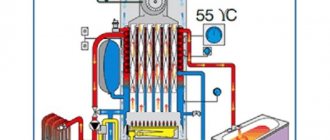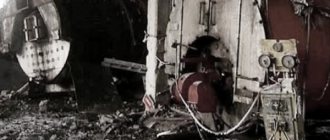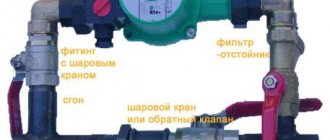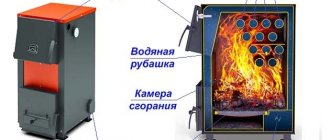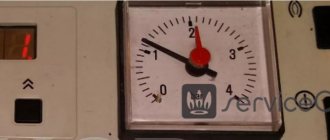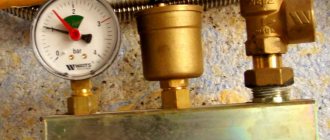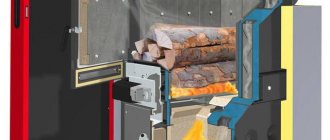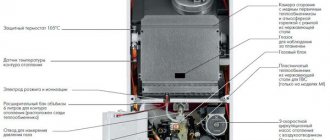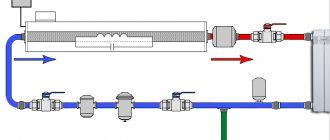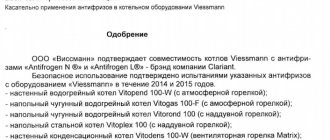Home / Gas boilers
Back
Published: 05/22/2019
Reading time: 2 min
10
32902
Gas boilers are designed to create comfortable living conditions. Double-circuit units provide the living space with heat and hot water at the tap. But it happens that a working boiler does not heat the water well and does not provide the necessary comfort.
The efficiency of the entire heating system depends on how the boiler operates. If there is a problem in the gas boiler itself, this can negatively affect the efficiency of the entire system and cause excessive consumption of energy resources. What happens when the boiler stops heating water? Let's look at the reasons and ways to solve this problem.
- 1 How does a boiler work?
- 2 The boiler does not heat water for heating
- 3 The boiler does not heat water for hot water supply
Design features of the gas boiler Baxi baxi, Navien, Ariston
In any case, it will be useful to become familiar with the equipment of this class and the features of modern models. This knowledge will help you choose the right equipment and avoid making mistakes during operation.
In household boilers Baxi (baxi), Navien and Ariston, gas, diesel and solid fuel are burned to heat water, and electric heating elements are used. To more fully utilize the potential of energy resources, heat exchangers are being improved. They make long ducts of complex shapes to ensure that the liquid remains in the working area for a long time.
The current trend is compactness. Manufacturers offer gas boilers with square bodies of relatively small thickness. Some models, due to their aesthetic characteristics, deserve to be placed in a prominent place.
The next feature is the introduction of automated control systems. They control the combustion process, change operating modes taking into account the readings of temperature sensors on the street and in individual rooms. If the equipment overheats, it turns off without user intervention.
It is necessary to carefully consider situations when the Baxi gas boiler does not heat the water. This happens, for example, when the supply of energy resources is cut off. It is not difficult to carry out an appropriate check even without special professional training.
Circulation pumps, valves, and other typical components and assemblies rarely fail. Their designs are designed for many years of operation without mandatory maintenance. Electronic circuits have no moving parts at all. Their breakdowns occur due to defects. Subject to the rules established by the manufacturer, the service life of modern gas heating boilers is more than 10 years.
Voltage surges in the power supply network can damage the electrical part of the equipment. To eliminate such influences, an external stabilizer is installed. It will be useful to check the grounding system. This completes the set of preventive measures for this group of problems.
It is much more difficult to provide protection against the most common cause of breakdowns of gas boilers - scale.
It is this that will be studied in detail in this article. When heated, calcium and magnesium salts are converted to a solid state. It is these impurities that clog narrow technological openings in heat exchangers. They also form a porous structure on the surface of electric heating elements. If normal heat dissipation is significantly disrupted, their housings are damaged.
To prevent the formation of scale and lime inside the boiler, it is advisable to install non-chemical filters (water converters), magnetic and electromagnetic, which will ensure a long “life” of your boiler and an uninterrupted supply of hot water, as well as protect the heating circuit.
The boiler does not heat water
This video is the solution to your problem!
Watch to the end and you won’t need to call a specialist.
It is impossible to survive without boiler houses in the climatic zones of Russia. Moreover, this also applies to the warmest regions, Sochi, Anapa and Rostov-on-Don. Winters are still harsh and people cannot survive without heating. Therefore, it will definitely not be possible to do without heating systems and hot water. And only boiler houses can provide the city with all this. Today we will look at the reasons why the boiler does not heat the water - how to solve this problem and what to do about it......
They are very different. It all depends on the heat source. It can be either steam or water. They may vary by location. If the house itself decided to build its own boiler room, then a specially separate room in the house can be allocated for it. Or extensions are made to the house for these purposes. One of the main requirements when constructing boiler houses is good ventilation.
If the boiler operates with steam, then very high demands are placed on the quality of water purification, and then steam. Therefore, it will definitely not be possible to manage such boiler houses without a whole complex of cleaning installations. This also includes AquaShield electromagnetic softeners, which are highly valued by boiler house employees today.
If a gas boiler suddenly stops heating water, the reasons may be different, but most often when using water from a central water supply without softening units, the cause may be limescale deposits. Moreover, it is hard and difficult to remove. The table shows possible signs of the reason why the boiler stops due to scale formation.
| Reason for boiler shutdown | Signs |
| High rigidity | Heating the bottom of a gas boiler, but at the same time weak heating of the water A sharp increase in electricity or solid fuel consumption White-gray coating on the bottom of the boiler The boiler does not heat the water to a certain temperature Poor pipe capacity Increased electrical conductivity of heat |
Other reasons for boiler shutdown are simpler. A piece of scale may also get stuck in the pipe and block normal operation, and a crack in the gas boiler may also contribute to the shutdown. But in these cases there will definitely be no scale residues on the walls of the equipment. If the boiler room does not have boiler water softeners or treatment facilities installed, then the root cause will of course be water hardness. If the treatment plant is standing and the equipment has been checked recently, then most likely this is not the problem.
If the video did not help you, then try installing anti-scale filters (polyphosphate or electromagnetic) in front of the boiler. Because Hard water and scale are the root cause of malfunctions and breakdowns of gas boilers!
In any case, if there is no cleaning in the system, then you will have to urgently address this cause and solve it. For boiler houses there is a whole range of water softening devices that are suitable:
- AquaShield;
- Ultrafiltration and conditioning for steam boiler houses;
- Ion exchange for economical consumers of gas boilers
The most wasteful process of cleaning and softening will be in steam boiler rooms. There you will have to remove not just all organic and inorganic impurities. Even dissolved gases will have to be removed. Degassing is quite troublesome and costly. But the operation of the boiler depends on the quality of the steam. This is where membrane softeners work to make the water completely isolated.
Many consumers of gas boilers choose AquaShield for the simple reason that it does not require maintenance and does not require spending money on it. But its biggest advantage for boiler equipment was and remains the ability to remove old lime deposits even in the most difficult places. Usually, to eliminate such residues, the equipment needs to be unscrewed, the parts need to be soaked in aggressive acidic environments and kept there for up to two hours. But even after boiler treatment of water, it is necessary to clean the surfaces with metal brushes or cleaners. If your gas boiler does not heat the water to the required temperature, then the reason is scale deposits. The electromagnet does all this work without damaging the surface, at the molecular level.
Elimination of some problems in the operation of the boiler
Of course, if one or another error code appears, you should immediately seek help from specialists who will eliminate it and advise on all operational issues . But some owners can independently identify this or that malfunction and bring their gas heating boiler into working condition.
Error 01
Gas boiler Navien KDB
The most common cause of such a malfunction is a blockage or reduced flow in the heating system, as well as a breakdown of the circulation pump.
To resolve this issue, follow these steps:
- Check the heating system and filter for the presence of air, and bleed it if necessary.
- Check the condition of the pump and the coil resistance for short circuits.
- Check the impeller in the circulation pump for any damage.
Error 02
If a double-circuit boiler displays error 02, warm water flows from the hot tap for a few seconds, and then cold water; on the remote control, the water temperature rises sharply to a maximum, and then drops sharply. At the same time, everything is fine with heating.
The reasons for such an error in the Navien boiler may be:
- Airiness of the heating system.
- Lack of water.
- The circulation pump is in working condition, but cannot reach rated speed, or the impeller has mechanical damage.
- The flow sensor in the coolant system does not function.
- The heating distribution valve is closed.
How to troubleshoot?
- The pressure in the system needs to be adjusted.
- Bleed any air in the system.
- Check the resistance of the pump coil for short circuit, inspect the impeller for damage.
- Check if the flow sensor has resistance to short circuit.
- Open the distribution valve of the device.
- Disassemble the sensor housing and clean the flag.
Most likely, the problem arose due to an air lock in the hot water supply system. The water in the circuit heats up as it should, but after air enters the heat exchanger, the temperature rises sharply to critical, which results in error 02.
Error 10
Connecting a gas boiler to the heating system
Error number 10 is usually issued in the following cases:
- The operation of the fan is disrupted, there is a bend, or the tubes from the air pressure sensor to the fan volute are connected incorrectly.
- The chimney is clogged.
- There are strong gusts of wind.
The malfunctions described above can be resolved as follows:
- It is necessary to repair or replace the Navien boiler fan.
- Check and clean the chimney if necessary.
- Check that the tubes from the air sensor to the fan volute are correctly connected and that they are bent.
Noise and hum without errors on the display
The problem is that the Navien double-circuit boiler makes a noise or hum when hot water is turned on, which is not similar to the noise from the pumps. In this case, the pressure in the heating circuit according to the pressure gauge is more than 1.5, and the boiler does not show errors on the display.
Elimination - the situation described is quite common in gas boilers. It is usually associated with clogging of the heat exchanger due to poor-quality coolant. There are two ways out of this situation - dismantling the heat exchanger and cleaning it or replacing the heat exchanger.
Error 011
011 is a coolant filling error. It is not provided for in Navien boilers adapted for Russian consumers, but is allowed only in those designed for the European market.
Innovative solutions in navien products
The most advanced ideas and technologies are implemented in Navien brand products. Products from this manufacturer are characterized by:
- Reliability - the designs include mechanisms that completely eliminate emergency situations.
- Convenience - all information about the system status is constantly displayed on the LCD display, and process management does not require skills.
- Versatility - brand appliances can be used both for heating a home and for hot water supply. And main and liquefied gas can be used as fuel.
- Safety - closed combustion chambers and the installation of a coaxial chimney guarantee the safe operation of the devices.
Errors and their codes
Error codes that may occur during the operation of Baksi gas boilers can be divided into two groups:
- complete blocking of equipment operation;
- switching the device to standby mode.
If the installation is completely blocked, you will need to restart the boiler manually. The blocking is activated if serious problems occur in the boiler operation, which can pose a serious danger to human health. Failures that cause the boiler to block include overheating of the equipment, and in addition, lack of draft. Blocking also occurs if there is no gas supply. The error resolves itself in rare cases. If this happens, the device starts in automatic mode.
Error E01
This error is the most common. When the flame control sensor is triggered, this code is displayed. Several reasons can lead to its appearance:
- no gas supply;
- there is no correspondence between phase and zero; this reason is relevant for phase-dependent models;
- no contact with flame sensor;
- the sensor is dirty or faulty;
- there are malfunctions in the ignition system;
- the gas valve is faulty or the electronic board is faulty;
- air access is insufficient for normal combustion;
- The gas pressure in the system is insufficient.
If this code appears on the display, then the first thing to do is check whether the sensor is connected correctly. It is also worth checking the gas supply. If everything is normal, then in this case you can press R. It should be held for 3 seconds.
If accidentally triggered, the equipment will continue to operate normally. If the error continues to appear, then in this case you should contact a specialist. Note that the occurrence of this error is associated with problems in the electronics. If you try to solve the problem on your own, then everything can end disastrously for gas equipment.
Error E10
Another common mistake is E10. The main reason for its occurrence is sensors that monitor the operation of pumps and monitor water circulation. This error may appear on the unit display in the following cases:
- the coolant pressure in the system has decreased;
- there is no contact between the board and the pressure switch;
- pressure switch is faulty;
- the pump operation sensor has become faulty;
- there are malfunctions in the pump;
- heat exchanger clogged.
If this error occurs, you should not try to fix it yourself. Self-repair is acceptable if the pump needs to be replaced. Carrying out this event will not be difficult. You can also clean the filters without assistance. All other work related to the repair of the Baksi boiler should be performed by an experienced specialist.
Errors E96, E97, E98
Urgent repairs by a qualified specialist are required if the gas boiler display shows errors E96, E97, E98. If they occur, it is unacceptable for the owner of the equipment to interfere with the operation of the boiler. The prohibition on intervention in the event of these errors is due to the fact that these three codes appear when the electronic board has become faulty.
Types and causes of malfunctions
If the Baksi boiler has stopped working normally, then you can carry out repairs on your own, without turning to specialists for help. But troubleshooting can only be done if the damage is minor and easily fixable. If you have never encountered boiler repair, then in this case you should not take risks - contact a specialist straight away.
- the boiler burner does not turn on or goes out;
- it is impossible to light the boiler;
- when the boiler is operating, popping noises are heard in the combustion chamber;
- boiler overheating;
- max becomes insufficient. coolant heating temperature;
- when the equipment operates there is a lot of noise;
- One of the system sensors fails.
Causes of failure of Baksi boilers:
- moisture has entered the boiler;
- the quality of the coolant used is low;
- the gas pressure in the gas pipeline has decreased or a drop has occurred;
- there was a voltage drop in the electrical network;
- The installation of the heating system was carried out with errors.
What to do if the Vailant boiler does not heat hot water
I found this way. At the entrance to the boiler I have a magnetic converter, which is supposed to remove water hardness, but it does not remove it, in my opinion this is a fiction. But the good thing for me is that it is installed right at the entrance to the boiler. You can see it in the photo below.
There is an American nut on it; after unscrewing it, you can easily pour citric acid into the inside of the pipe.
But to do this you need to turn off the water. I have a collector next to the boiler. He is in the photo below.
Now all the channels on it are open and with one easy movement I turn off the water supply to the boiler.
All water is shut off, now you can unscrew the American connection on the magnetic filter. And don’t forget to come up with something from the flowing water from the boiler, there isn’t a lot of it, but it is there. I wrapped up the rag.
Then I pour citric acid into the inside of the pipe.
I screw the American valve back and open the tap for supplying tap water to the boiler.
Now it is important to understand when the acid will enter the heat exchanger. Since my water tap is located a meter from the boiler, I determine whether the acid has reached the heat exchanger to taste
I just open the tap in short jerks and taste it to see if it’s “sour”, which means the entire system from the magnetic filter to the tap is filled with citric acid.
Next, you need to turn off the tap so that your household does not drain all the acid ahead of time.
I charge the system at night and it stays acidic until the morning. In the morning I open the water supply tap to the boiler and drain all the acid. The water will hiss, don’t be alarmed.
The question may arise, will the acid eat away at the heat exchanger? I did some digging on the chemists' forum and came to the conclusion that organic acid (citric acid) is harmless to copper.
I use this method when necessary. If you don’t like how the boiler heats the water or the pressure of hot water has become weak, I take the heat exchanger and treat it with citric acid.
If you have connections to the boiler made of polypropylene, and there is no place to put the acid, then come up with something similar; it won’t take much time.
Navien Ase boiler does not heat water well
I’ll answer instead of Olga How I do it. Naturally, I turn off everything: gas, water, turn off the electricity. I remove the main heat exchanger. I disconnect the sensor connectors, unscrew the ground wire. I unscrew 4 screws, remove the gas supply tube (the upper and lower screws are of different lengths). I unscrew three self-tapping screws with engravers and remove the turbine volute. I remove the plastic tubes for supplying water to the heat exchanger. Take out the spring clamps and simply pull off the tubes. They are sealed with silicone rings. When reinstalling them, they must be lubricated. Next, I unscrew 6 screws and remove the heat exchanger with the burner. I recommend it for this procedure, get yourself a long screwdriver, about 30-35 cm. On the right side, access to the two screws is not very convenient. Here in front of us is a heat exchanger assembled with a combustion chamber. We clean the outer surface of the heat exchanger. It’s better not to disassemble unless unnecessary, the seal can be damaged and then gas breakthrough will occur and burnout is guaranteed. How to do the flushing itself. I take... a car wash, I have a karcher k5. I put in a mud one I simply press the cutter against one of the heat exchanger tubes. I press the trigger of the gun. I wait until clean water comes out. I repeat the procedure several times, alternating the supply and return tubes. until the dirt and lime stop flying out. I drain the remaining water and pour in a descaling agent. I won’t advertise a specific brand, the main thing is that there is liquid. I wait for the reaction to stop, sometimes foam comes out of the tubes. For better filling, you need to rock the heat exchanger. Then I rinse again several times. I drain the water and put everything back. Once again I pay attention to the correct installation of the self-tapping screws. Where the short ones were, screw in the short ones. If you screw in a long one, there is a risk that you will screw it into the heat exchanger tubes, thereby breaking the tightness. Same with the analysis wash the DHW heat exchanger. Naturally clean the dirt filter. Just hold the U-shaped bracket and remove the filter. You can clean the liquid flow sensor. It is located on the exchanger supply tube. It is a reed switch type, controlled by a magnet; this magnet becomes overgrown with dirt and sludge and loses its mobility. The boiler is igniting an error 02. We removed the sensor from the tube, unscrewed 4 self-tapping screws and now we have access to the guts of the sensor. Remove the flag with the magnet and put everything back together. It seems like I’ve indicated all the nuances. You can, of course, assemble a hadron collider from a bucket with a boiler and a Gazelle El.pump. Pour citric acid into the bucket and run everything around the boiler, like washing the entire system. But I described my method.
Control board errors
The control board should be considered as the cause of hot water problems when all other checks have failed. The cause may be a malfunction in the flame modulation circuit. The boiler control unit constantly adjusts the burner power depending on the conditions, and if there is a fault on the board, the boiler can spontaneously reboot or turn off when it reaches maximum power, which in most cases is required precisely in the hot water preparation mode.
It is also possible that boards may be configured incorrectly as errors. But this only applies to those cases where problems appeared after its replacement. BAXI boards are universal and require customization for a specific boiler.
Italian Baxi gas boilers occupy a strong place in the heating equipment market due to their high efficiency, stable operation even in adverse conditions and thoughtful stylish design
.
But, despite their high reliability, sometimes
malfunctions occur
in the operation of Baksi boilers caused by violation of operating conditions or failure of individual boiler elements. Most often, you can eliminate them yourself, without calling in specialists.
The Baxi line of gas boilers includes a number of models that differ in volume, type of installation, and functionality. However, the principle of their operation is generally similar.
The most popular boiler models:
- Baxi Luna (Baxi Luna);
- Baxi Slim (Baxi Slim);
- Baxi Main four (Baxi Main for);
- Baxi Main 24 fi (Baxi Main 24 fi);
- Baxi Nuvola (Baxi Nuvola);
- Baxi EKO four (Baxi Eco for, Baxi Ecofor).
By installation type
Gas boilers are divided into
wall-mounted and floor-mounted.
Wall heater is fixed
using special brackets
in any convenient place,
which makes wall-mounted models very popular. Chambers with a closed combustion chamber, for example, Baxi Main 24 fi, have increased efficiency and environmental friendliness in a small size.
Coolant volume
in the heat exchanger depends on the model, in the most powerful it
reaches 80 liters
.
In terms of functionality,
models
can be single-circuit
- for heating, or
double-circuit
- in addition to the heating system, they also supply the hot water circuit.
Work
They can use
both natural main gas and liquefied gas
from cylinders, making it possible to install them in non-gasified areas.
The boilers are completely volatile
and require connection to an alternating voltage network.
Operating principle of gas heating equipment:
- Sensors analyze the temperature in the room, and when the minimum value is reached, they send a signal to turn on the circulation pump.
- The pump turns on, creating a vacuum in the return pipe, and the heated water enters the heating system.
- The microprocessor sends a signal to ignite the burner at low power, it gradually increases, and the coolant is heated to a temperature specified by the user.
- Then the boiler operates in modulation mode - it maintains the temperature within the specified limits, turning on when it drops.
At any of these stages, a malfunction may occur, which the boiler notifies using coded errors.
Possible malfunctions of the Baxi Main for, Baxi Main 24 fi, Baxi Eco for boiler:
- the burner goes out immediately after switching on or during the heating process (error codes e01, e04);
- ignition of the boiler is impossible;
- overheating occurs (error code e02);
- The water pressure in the system drops (error code e10);
- extraneous noise is heard during operation;
- there is popping noise in the combustion chamber;
- the coolant does not heat up to the set temperature;
- One of the sensors fails (different error codes may appear).
The most common causes of certain malfunctions, according to service center specialists, may be:
- wrong
- errors when connecting the boiler to the electrical network;
- water getting into the circuit board, burner or electrical part of the boiler;
- low quality of network water or other coolant;
- sudden drop in gas pressure;
- The network voltage drops or increases unacceptably.
The resulting malfunctions can be easily eliminated by adjusting the boiler, but sometimes it is necessary to call a specialist to replace boiler parts.
What kind of breakdowns can occur in a Navien gas boiler?
Most often, consumers choose a Navien double-circuit gas boiler; its faults are displayed on the display. Many users on the forums are interested in what error codes mean and how to fix problems.
As practice shows, the occurrence of malfunctions is mainly associated with improper installation and operation of units, as well as with voltage surges and the use of low-quality coolant.
Navien floor-standing gas boilers - pros, cons and model range
Floor-standing single-circuit gas heating boilers - what is important to pay attention to
The manufacturer has provided the following fault codes for Navien gas boilers:
- 01E – system overheating;
- 02E – lack of coolant or the flow sensor circuit is broken;
- 03E – no flame signal;
- 04E – short circuit of the flame sensor circuit or false message about the presence of fire;
- 05E – temperature sensor circuit connection failure;
- 06E – temperature sensor circuit short circuit;
- 07E – connection failure of the DHW temperature sensor;
- 08E – short circuit of the DHW sensor;
- 09E – malfunction of the coaxial chimney fan;
- 10E – failures in the combustion product removal system;
- 13E – short circuit of the heating system flow sensor;
- 27E – malfunction of the APS sensor circuit;
- 15E – malfunction of the control board.
If some error codes appear, only a service center specialist will help solve the problem. However, you can try to fix certain problems yourself without involving a technician.
Work principles
Gas boilers, as a rule, have two circuits - heating and water heating. Double-circuit devices are a combination of several blocks responsible for a certain functionality of the system. Thus, the gas block is responsible for igniting and burning the burner, which allows the heat-conducting liquid to heat up, the water unit supplies water and ensures the necessary pressure in the line, the smoke exhaust unit releases combustion products into the environment, the control unit controls the operation of all boiler systems.
When the unit is started, water is pumped into the system using a pump, passing through the heat exchanger pipes. As soon as the liquid has entered the water unit, the gas supply valve opens and the burner is ignited. The process of heating the heat exchanger body occurs evenly and is controlled by temperature sensors.
Important! The heating cycle is regulated by sensors. When the water temperature drops to a certain temperature, it is the sensors that transmit an impulse to the control module to resume heating
When hot water enters the mixer, a flow sensor is connected. A signal is sent from it to the board, after which the three-way valve is activated and switches to heating the water supply.
Radiator does not heat up
Most often, problems with normal heat transfer occur in heating radiators. This is explained by their specific design - the coolant does not move through one pipe, as in a transport line, but is distributed over several.
In what cases does the heating radiator not heat? There are several factors that directly affect the correct operation of the battery.
Air locks in heating
There are several reasons for the appearance of air locks in the heating system - excess temperature, water evaporation, etc.
It is important that the consequence of this is the appearance of places in the line that are not filled with coolant. Most often these are heating radiators
To eliminate them, it is necessary to install a Mayevsky valve - an air valve that releases excess air from the device.
How to determine why a radiator does not heat well? The simplest method is a temperature difference on the surface. At the point where the air lock forms, it will be significantly lower, thereby preventing the normal passage of the coolant. To eliminate it, you must perform the following steps:
- Using a screwdriver or a rotary lever, the Mayevsky tap is opened;
- Add water to the system until the coolant begins to flow out of the tap along with the air;
- Shut off the water supply.
After starting the heating system, the surface of the radiator should heat evenly. Otherwise, repeat the procedure.
Improper installation and limescale deposits in pipes
The efficiency of its operation depends on the correct installation of the radiator. It should not be inclined relative to the plane of the floor and wall. If this condition has not been met, then the question will inevitably arise - why the heating battery does not heat.
To check the correct installation of the radiator, you can take a standard building level. If the upper plane of the battery has deviations, re-installation should be performed. It is best to use new reinforced fasteners for this.
If after this the question of why the heating radiator does not heat remains unresolved, it is recommended to flush the heating system. This problem is relevant for old pipes and radiators made of steel and cast iron. Over time, a limescale layer accumulates on the inner surface, preventing the normal flow of coolant. There are several ways to perform the washing procedure:
- Hydraulic. A special pump is connected to the system circuit, which creates high water pressure. Under the influence of this force, the scale is broken into small fractions and retained in the pump filter;
- Chemical. Special additives act on limescale, which loses its uniformity and flakes off from the inner surface. Subsequently, hydraulic flushing is performed to remove residual debris.
Experts recommend using a comprehensive method to solve the problem in which the radiator does not heat up. After checking the correct installation, the system is flushed, and then filled correctly with the Mayevsky tap open.
If a two-pipe heating system does not heat due to clogged pipes, you need to carefully choose a cleaning technology. For pipelines made of polypropylene, chemical cleaning cannot be done.
The boiler does not reach temperature - reasons
Electric
Let's try to figure out why your electric boiler does not reach the set temperature; as a result, you have cold batteries.
The reasons may lie in the following:
- If you have several heating elements for heating, perhaps one of them is not connected, the problem may be caused by poor contacts of the wires suitable for the heating element, or it has burned out.
- The wiring in your home does not match the power consumption of the device. Perhaps the reason lies in the wrong cross-section of the wires. If, however, this is due to insufficient voltage in the network or its surges, the solution may be to connect through a voltage stabilizer.
- If only one of the batteries remains cold, while the others remain within the set temperature range, this most likely indicates an air lock.
To remove air you will need to do the following:
- Open the Majewski tap using a screwdriver or rotary lever.
Mayevsky tap on a heating radiator
- Gradually add coolant to the system until it begins to flow out of the tap, this will mean that the air has been removed.
- Stop the coolant supply.
- If uniform heating does not occur, repeat the procedure again.
- If it does not heat more than 40-60 degrees, the main burner flame may not be adjusted. To do this, unscrew the screws that hold the casing, find the gas supply regulator to the main burner and, by rotating it clockwise, increase the flame power.
- When the output is 70 degrees and returns 15 degrees, that is, the system does not maintain the water temperature.
The coolant speed is set incorrectly; it needs to be increased. Also adjust the radiator system so that more heat reaches the last radiators. If you have a circuit with natural circulation, it is possible that the incorrect angle of inclination was set during installation; according to the norm, it is 20 mm per 2 lm. - Perhaps the automation malfunctions, and when the temperature rises by 60 degrees, the nozzles turn off. It is necessary to adjust the operation of the automation.
- Does not maintain the set temperature. An inappropriate power for the heated area was selected.
- The gas pressure in the system is less than required. Check the gas valve; older generation valves contain grease inside; if there is too much of it, remove excess.
- The diameter of the pipe and the hose suitable for the device do not match. Their inconsistency can contribute to unsmooth operation.
- If the heating boiler does not reach the set temperature, the heat exchanger may be clogged, clean it.
Scale inside the heat exchanger
It happens that the heating elements are clogged with scale, and the temperature does not rise to the set value. For example, on the Mora TOR model, this problem occurs very often due to poor water quality. To clean, you need to remove the heating elements; the top layer of scale can be cleaned with a screwdriver, scraping off large scale elements, then soak the heating elements in a special solution.
Gas
The situations under consideration are applicable to the following models: Buderus, Conord, Baxi, Proterm, Navien, Vaillant, AOGV, Danko.
The reasons may be the following:
Solid fuel (including coal, pellet, wood)
Possible reasons why the temperature does not rise:
- The selected power is not enough to heat the area of the room with a solid fuel boiler, or the house is very frozen and the device cannot cope. This often happens with Lemax, Aton, Stropuva devices.
- Check the tightness of the firebox; if depressurization is detected, seal the holes.
- The size of the chimney does not correspond to the diameter of the chimney pipe on the boiler; match the chimney pipe and the pipe.
- Poor draft in the chimney or it is clogged. The damper may be closed and there is not enough oxygen for combustion.
- Low quality raw materials, or low calorie content. If the boiler is wood-burning, the raw materials may be poorly dried or rotten; if it is coal-fired, in this case there may be an increased content of rock.
- The volume of the combustion chamber is not enough. The maximum filling has been made and there is no room for the flame to burn.
- The wrong fuel is used; if the boiler is pyrolysis or pellet, the instructions should indicate what else can be used to fuel it.
If the temperature drops quickly, this indicates insufficient power of the device, or the heating circuit is too long. What to do in such a situation? A possible solution is not to use hot water during heating, but to use a boiler to heat hot water for domestic purposes.
Features of Navien gas boilers
The Navien double-circuit gas heater stands out among a huge number of competitors for its compactness and attractive design.
Even if low-quality gas is used, subject to the requirements and recommendations of the manufacturer, the Navien gas boiler will please the owner with reliable and long-term performance of complex and expensive repairs.
The Navien gas boiler is capable of maintaining functionality with voltage drops of up to 30%, a drop in gas and water pressure in the supply lines. Navien boilers, regardless of type, are equipped with systems that guarantee uninterrupted operation under various operating conditions. The antifreeze system will prevent water from freezing during the cold season.
The control system is intuitive and can be adjusted remotely. The design uses steel heat exchangers, guaranteeing high efficiency and long service life.
The air pressure sensor used in the circuit ensures complete combustion of the fuel, which leads to lower costs. The water heating mode is activated simultaneously with the opening of the hot water tap. The burner automatically starts up, and when the tap is closed, the system goes into standby mode. The boiler heats water only for the heating system. The winter-summer mode automatically switches the system to DHW or vice versa.
The Navien boiler has a closed combustion chamber. The coaxial smoke removal system prevents combustion products from entering living spaces.
A wide range of temperature settings, both room and hot water, makes the Navien boiler competitive even with representatives from high price categories.
Gas boiler Navien, main faults and their elimination
Do-it-yourself repairs require certain knowledge and skills in working with gas equipment. There is a special manual that describes the main fault codes. There are no repair instructions provided for users. The manufacturer assumes that troubleshooting will be carried out exclusively by service centers.
But many breakdowns can be fixed on your own without wasting time and money on a professional technician. To do this, it is enough to familiarize yourself with the main malfunctions and their elimination.
Navien gas boiler does not start
If the system does not turn on the control panel, then the problem is usually a lack of power from the electrical network. If the power supply is turned off by utilities, you should wait until the supply is restored. To understand how to turn on the equipment, just plug the cord into an outlet.
A common problem is the gas boiler turning on and off frequently. The source of the malfunction is an incorrectly installed circulation pump. The heating often turns off when the temperature range is incorrect. Also, the equipment turns on and off every 5-7 minutes in the absence of a thermostat.
The Navien boiler does not reach the set temperature
The most common malfunction of a Navien gas boiler is that the system does not heat up to the specified parameters. To fix the problem, you need to clean the heat exchanger using household plumbing chemicals or specialized compounds. To do this, the device is dismantled, the selected solution is poured into it, after which the part is thoroughly washed with a large amount of water. If the boiler does not heat hot water, then you can clean the heat exchanger of the DHW circuit in the same way.
The Navien boiler quickly gains and drops temperature
If the Navien gas boiler quickly heats up and cools down, then the fault should be sought in the heating system. You can adjust the pump speed to force fluid movement or remove air pockets.
We recommend: Choosing the best insulation for walls in a frame house
During diagnostics, it is necessary to inspect the filtration system and the lumen of the heat exchanger. You may also need to replace the antifreeze. Spare parts for Navien gas boilers are freely available - they can be ordered online or purchased in a specialized store.
Malfunction of the boiler ventilation system
If you do not use Navien Deluxe floor or wall heating equipment for a long time, a lot of dust accumulates inside, which negatively affects the operation of the fan. To fix the problem, you will need to clean and lubricate the system.
Water oversaturated with oxygen
During natural circulation, water bubbles form, which burst and cause noisy operation of Navien Ice 24 and other models. If you add membranes to the system, the problem will disappear.
Pressure failures
Failures in water pressure of Navien heating devices are usually associated with leaks. The coolant penetrates into all small cracks, which affects the operation of the equipment. Also, the reasons include a malfunction of the three-way valve or secondary heat exchanger.
DIY Baxi boiler repair Video tutorial
Burner flame does not reach maximum power
The cause of the malfunction may be incorrect pressure setting in the heating system, a malfunction of the gas valve modulator, or a breakdown of the diode bridge.
Remedy: adjust the system parameters using the boiler operating instructions.
The boiler starts and immediately stops working
The reason is low gas pressure in the gas pipeline.
Remedy: reduce the incoming gas pressure to five mbar (standard - twenty-five mbar).
Weak heating in the hot water supply system
The reason for this is the incomplete opening of the three-way valve or its breakdown. To confirm a valve malfunction, you should allow the system to cool, close the shut-off valves of the heating system, then turn on the boiler in hot water supply mode. If the valve is faulty, then heating in the heating system will occur simultaneously with the DHW.
When igniting a “popping” sound is heard in the boiler
This noise appears due to: insufficient gas combustion (minimum pressure adjustment is necessary); changes in the distance from the gas supply to the igniter during careless transportation of the Baxi boiler (the gap should be adjusted by setting it to 4-5 mm); excessive draft (use a damper to reduce the draft in the boiler).
How to adjust the gap between the burner and the igniter
Open the front panel and completely remove it from the boiler. Remove the damper from the inspection hole. Behind it is an igniter
To change the gap size, you need to unscrew the screw that secures the igniter electrode, then remove it and carefully bend the electrode. Then we install it in place and close the hole flap
A sharp decrease in coolant temperature in the circuit
The reason for this is: clogged filters (they need to be cleaned or replaced); damage to pipes, radiators, their clogging or freezing (the malfunction must be identified and replaced or the defective section of the pipeline must be cleaned).
How to clean the primary heat exchanger with your own hands (video)
We drain the water by unscrewing the tap on the boiler on the right. If possible, drain the water from the heating system. For cleaning we use a device called Jelly. We connect the pipes of the device to the heating pipes of the baxi. Unscrew the cap on the device and fill in cleaning liquid. We turn on Zhel in the electrical network. Over the course of a couple of hours, use the knob on the device to switch the direction of the washing liquid “forward - backward”. After two hours, turn off the device and unscrew the tap to drain water from the baxi boiler. We remove the hoses, making sure that the washing liquid flows back into the device. We connect the boiler to the system and fill it with coolant. Cleaning the boiler will remove scale from its parts and prevent clogging and breakdowns.
Cleaning the secondary heat exchanger (heating circuit)
We use the washing device again. We connect it to the boiler and turn it on. The gas tap should be closed and the hot water tap should be opened. And after that, turn off the cleaning device. Thus, the liquid will be driven along a short circuit of the system.
Before installing the boiler, operating it or repairing it, be sure to consult a specialist. Despite all the positive qualities of baxi boilers, they, like all equipment, have their own margin of safety and service life. In this article, we looked at the main types of breakdowns, and also saw how to repair Baxi boilers with your own hands. We wish you and your boilers success.
“Baksi” is the name given to the line of gas boilers from the Italian company. If you are faced with the task of ensuring a comfortable microclimate in the room, then Baksi boilers are the best solution. The installations of this manufacturer have many advantages. The most important thing is that Baxi boilers are economical. In addition, they can be used for a long time and do not make noise during operation. These units perform well during use and are also easy to use. The reasonable price of this equipment makes it accessible to most consumers.
Malfunctions of heating boilers
A dirty heat exchanger is a common reason for the lack of hot water in the DHW circuit.
Common boiler breakdowns include:
- coolant leak;
- water hammer;
- after turning on the burner, the lock is activated;
- the burner does not turn on;
- fuel burns unevenly, in waves;
- soot is formed;
- decreased productivity;
- During operation of the burner, the ignition is switched on;
- soot forms on the walls of the chimney and combustion chamber.
To resolve a problem, you must first determine the cause of the problem.
Built-in pump malfunction
The reason for the lack of hot water may be a clogged built-in pump.
An important part in the heating system is the circulation pump. The quality of heating and the functioning of hot water supply depend on its uninterrupted operation. There are several signs and causes of breakdowns:
- The unit makes uncharacteristic sounds. This occurs due to oxidation of the shaft, the entry of a foreign object into the structure, problems with the power supply, air in the pipes, dry running of the mechanism, and the appearance of cavitation.
- After turning on the boiler, the pump does not start. Perhaps there is no power supply, the fuse has tripped.
- After a short period of time after switching on, the structure switches off: limescale deposits in the stator shell.
- Hot water does not turn on in a double-circuit boiler.
Also, the reasons for poor operation of the circulation pump are poor pressure in the system, wear of the bearing, which causes additional vibrations in the line, and low pressure.
To troubleshoot problems, you need to check the presence of electricity, clean the pipes and other elements, replace failed parts, and remove foreign objects from the system.
The heat exchanger is clogged
You can clean the heat exchanger from scale using a solution of citric acid and an electric charge.
Heated gases are transported through channels, which are collectively called a heat exchanger. The design features are that the walls of the artery simultaneously serve as partitions of the water circuit, along which the coolant constantly moves, heating the metal surface. The combustion process is associated with the intense release of flue gases, partly consisting of soot and tar, which create a deposit inside the boiler, on the chimney. Therefore, the manufacturer recommends regularly cleaning the equipment at least once every 30 days and during the preparation of the device for the heating season.
We recommend: A stove being used in a garage: pros and cons, drawings, how to make it yourself, video
When soot settles on surfaces, the performance of the mechanism decreases, fuel consumption increases, and the risk of costly breakdowns and internal fire in the contaminated area increases.
Chemical cleaning of bithermal heat exchanger
Washing is carried out without dismantling the heat exchanger; to perform the procedure, you will need a booster with a volume of 20-30 liters. Before starting work, it is necessary to drain the coolant from the heating system using a Mayevsky tap.
Fill the booster reservoir with the flushing solution, and lower the hoses into the container, the free ends of which are connected to the heat exchanger pipes. Liquid movement is possible only under the action of a circulation pump; it must be connected to one of the hoses.
The ends of the hoses must be put on the heat exchanger pipes, and the free ends must be placed in a booster with flushing liquid, connecting the circulation pump. Work can be performed without removing the heat exchanger
It would be ideal to connect a reversible pump with the ability to change the direction of fluid flow. All that remains is to start the boiler for heating at a set temperature of 50-60 degrees and leave for 15 minutes, periodically changing the direction of circulation.
Chemical cleaning of the secondary heat exchanger
Flushing the secondary heat exchanger of a double-circuit gas boiler can be performed in a similar way to flushing a bithermic heat exchanger. However, you need to take into account that the secondary heat exchanger is easily removed, so you can improve the quality of cleaning by dismantling it.
To gain access to the heat exchanger, it is necessary to dismantle the front panel of the unit and move the control unit to the side. The heat exchanger is secured with two bolts at the bottom, which can be easily removed by unscrewing them.
It is most effective to place the heat exchanger removed from its original location for washing in a container with a salt-dissolving solution and boil it. Instead of a suitable household product, you can use a 20% citric acid solution.
Good results can be achieved by boiling the secondary heat exchanger in a washing solution
When cleaning any heat exchanger, the final stage is rinsing with clean water. This measure is necessary to remove traces of a chemically aggressive substance and stop its effect on the walls of the heat exchanger.
There is another way to clean the heat exchanger - hydrodynamic. Its implementation requires special equipment and pressure control at each stage of cleaning. Therefore, without special knowledge and skills, doing it yourself can be dangerous.
Regular cleaning of the heat exchanger will avoid the need to use very aggressive compounds and will make it possible to extend its service life. It is recommended to clean the heat exchanger annually at the end of the heating season.
Problems with the heating circuit
The pump must be selected according to the requirements of the heating circuit.
Malfunctions in the operating mode of the heating circuit are not always associated with a malfunction of the main heating element. If the boiler works, but does not heat the batteries, the reason must be sought in the wiring itself.
List of main heating circuit malfunctions:
- the filter on the return line or the needle tap (Maevsky tap) is clogged;
- insufficient power of the circulation pump;
- the rules for installing a heating circuit with natural circulation have not been followed.
Any of the above problems must be resolved before the start of the heating season. Otherwise, the room may be left without heat for several days, since the repair involves completely draining the coolant.
So, why doesn’t the boiler heat the batteries if everything worked fine over the previous years? The reason is a dirt plug that has formed on the heating circuit filter and completely blocks the coolant flow. It can be solved simply - the water is drained from the pipes or its circulation is blocked using bypasses, and the filter is cleaned. To prevent a recurrence of such a situation, it is necessary to completely replace the coolant with parallel flushing of the entire circuit.
In a gravity system, the slope of the pipes is key.
The second reason why the boiler works but the radiators are cold is the insufficient power of the circulation pump. The performance of the device is not enough to pump the entire volume of coolant in a timely and efficient manner. Or the heating system in the house has branches that are located at a significant distance from the pump. As a result, the circulation pump overheats, the heating equipment operates with excessive energy consumption, and the radiators remain cold. The solution is to change the coolant pumping device to a more powerful one.
If the house has a two-pipe heating circuit with natural circulation of water, and during the heating season it is often noticed that the boiler is on and the radiators are cold, then the reason lies in non-compliance with the slope of the main line. According to regulatory documentation, only a pipe slope of 10 mm per linear meter in a heating system with natural circulation will ensure normal coolant movement. The result is uniform heating of the batteries throughout the house. If there is no slope, the coolant stagnates, which negatively affects the temperature of the radiators. The problem can be solved by completely redoing the wiring.
Modulation errors on the burner
To heat running water, in most cases a boiler power close to maximum is required. In modern boilers, the burner power is regulated over a wide range. The adjustment occurs by changing the amount of gas supplied by the gas valve. The amount of adjustment is determined by the control board depending on the operating logic and settings. The process can be observed visually by the height of the flames on the burner.
If the boiler settings are set to 100% boiler power in DHW mode, but visually the flames on the burner are weak, or obvious interruptions are visible, then you should check:
- setting the gas valve (static and dynamic gas pressure)
- control board
Such checks should only be performed by a qualified person.
Three-way valve
A three-way valve is installed in boilers with two heat exchangers. When a signal is received from the flow sensor, the electronics gives a signal to the valve and the heated water from the first heat exchanger is sent to the second heat exchanger, where the heat is transferred to the passing tap water. If, for example, no actual switching occurs (the valve is faulty), then the coolant will continue to circulate in the heating circuit and no heat transfer to the hot water circuit will occur.
If, for example, a valve only partially closes the heating circuit due to a malfunction, then there will be problems with insufficient heating of hot water, since part of the heat will go to the heating system.
We recommend: Which wall-mounted double-circuit gas boiler is better: TOP-6 best models and companies in terms of reliability, characteristics and quality, how to choose a wall-hung boiler for heating and hot water supply, current prices
Problems with the flow sensor
A possible reason why a gas boiler may stop heating water is a problem with the flow sensor. The device is a small fan that rotates under the influence of water flow. As a result of rotation, a signal is sent to the control board to heat the water. Due to clogging, the fan may stop rotating.
You can clear the blockage without dismantling the device. To clean it, just open and close the water supply tap several times. If such actions do not give the desired result, you will have to remove the sensor and clean it.
To do this you need:
- Disconnect the gas boiler from the electrical network;
- Turn off the water supply tap;
- Drain the water from the unit.
Typically, the flow sensor is secured with a bracket, by removing which you can easily remove the device. The assembly is removed completely; to remove the inner part, you need to turn the parts in the groove. During disassembly, you should clean the filter mesh and remove the turbine.
Often, turbine blades are covered with a layer of rust that needs to be thoroughly cleaned. If you remove the three clamps, you can remove the turbine itself to clean the internal plane of its landing. Now all that remains is to reassemble in reverse order.
When disassembling the flow sensor, you need to clean the filter and turbine blades
If cleaning the flow sensor does not bring the desired result and there is no hot water, you will have to replace the entire assembly.
The main problems are why the boiler does not heat water
More often, boiler problems are detected during the heating season, when both circuits of the device are operating. There are two main problems that owners of wall-mounted gas boilers such as Ariston face:
- all boiler systems are working, the device turns on, but heats the water poorly or does not heat at all;
- the boiler does not start and, as a result, no hot water is supplied.
Each of these problems has its own causes and solutions. To troubleshoot problems, you need to figure out what caused them and what caused them.
Before finding out the reasons for the malfunction of the unit, you should look at the operating manual, read the instructions and check that the settings and connections of the device are correct.
Note! Modern gas boilers are equipped with a diagnostic system that detects faults and displays an error code on the display. The instructions for the unit will help you decipher the codes.
If all requirements and conditions are met, the most common causes of malfunctions should be considered:
- Blockage. Experts say that using unfiltered working fluid increases the risk of clogging the heat exchanger pipes. The resulting scale reduces its thermal conductivity, which causes the unit to operate with excessive energy consumption. In this case, the optimal temperature regime is not achieved even with continuous operation of the device. Due to limescale deposited inside the heat exchanger pipes, the metal is subject to corrosive changes, which can lead to its rupture.
- Faulty pump. The circulation of the coolant may be stopped due to the accumulation of air, the so-called air lock in the pump. The second cause of a pump malfunction may be a rotor that is jammed. A circulation pump that stops functioning can lead to overheating of the gas boiler.
- The flow sensor is stuck. Inside the boiler there is a sensor in the form of a turbine, resembling a small fan. When the turbine rotates inside the sensor, an electrical pulse is generated due to the fluid flow, which is supplied to the control unit. This way the electrical system understands that it needs to warm up the coolant.
- The three-way valve is stuck. Such a malfunction will not allow you to switch the water supply from heating to DHW. Valve stoppage can occur due to blockage, either in the part itself or in the gas hose or filter.
- Insufficient pressure. If the volume of liquid in the system does not create the required pressure, the water supply valve does not open, which leads to burner ignition failure.
Possible solutions to the problem
When you know the reason why the boiler does not heat the water, you can try to eliminate it yourself. Manufacturers often make mechanical components available for self-service.
Important! When troubleshooting problems on your own, before starting work, you must disconnect the unit from the electrical power supply and free the internal components from the coolant.
Further on the situation:
- If the heat exchanger is clogged, you can clean it using special liquids, or using proven home remedies for descaling. In the future, it is better to use filter devices at the coolant inlet to the boiler.
- If the cause is a faulty pump, you should disassemble it and inspect the rotor. If foreign particles are found that block free movement, they must be removed. The filter should also be inspected for clogging.
- When the cause of the malfunction is the water flow sensor, it is necessary to remove from it the part containing the turbine inside. If, when rotating with your finger, it begins to click or slow down as it moves, this means that there are foreign particles in the body. You should try to flush the turbine and clean each of its blades using a cotton swab dipped in cleaning fluid.
- The three-way valve, if it caused a boiler malfunction, also needs to be cleaned, and at the same time check the gas hose and filter.
- If the pressure is low, you should check all fittings and valves on the device, the pressure with which water flows from the mixer. If there are no leaks and the pressure is weak or absent, then simply replenishing water in the expansion tank will help solve the problem.
One of the main tips is to follow the operating rules and follow the manufacturers' recommendations. It is important to remember that prevention is always more profitable and better than repair. Timely maintenance and checking of the main components of the system will extend the service life of the autonomous heating device.
One of the best in terms of price-quality ratio are Korean gas boilers Navien. These units have a lot of advantages, are quite reliable and inexpensive. However, during the operation of Navien gas boilers, malfunctions also occur. Let's look at what they are connected with and how to eliminate them without resorting to the help of specialists.
